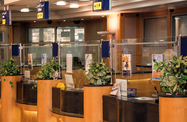Early indicators suggest that investor sentiment in Bahrain has been largely unaffected by a recent credit rating downgrade from Standard & Poor’s (S&P).
Ratings action
In mid-February S&P lowered Bahrain’s rating by two rungs from “BBB-” to “BB” with a stable outlook, citing concerns over falling energy revenue and rising public debt levels.
“We expect the impact of lower oil prices will further strain Bahrain's already weak fiscal and debt metrics,” the S&P statement said.
Bahrain’s net debt position is expected to reach 35% of GDP by the end of this year, nearly quadruple the 9% recorded at the end of 2014.
Despite some measures by the government to consolidate spending and rein in debt, Bahrain remains vulnerable to oil price fluctuations and external risk, the agency said.
While this was followed by a similar move on the part of Moody’s, which downgraded the kingdom’s long-term issuer rating from “Ba1” to “Baa3” in early March, the other leading ratings agency – Fitch Ratings – has not yet followed suit, though the agency did revise the country’s outlook from stable to negative in December.
Bond rebound
The most immediate effect of the downgrade was the cancellation of a $750m bond offering that the Central Bank of Bahrain (CBB) had launched earlier in the week.
There had been strong interest in the offering, initially billed at $500m, with $1.35bn worth of orders submitted.
Nonetheless, the CBB opened a new $600m debt sale just one week later, albeit somewhat lower in value than the earlier bond and with higher yields.
The offering was structured in two segments, with a $275m five-year tranche priced at a yield of 5.95% and a $325m, 10-year tranche set at 7.65%. The coupon rates exceeded those of the cancelled offering, but only marginally so, with each tranche priced at a premium of 25 basis points.
The bonds were oversubscribed to the tune of 50%, attracting orders of more than $900m, media reported, in a solid indication that Bahraini debt continues to hold appeal for investors despite the recent ratings reduction.
The premium is seen as fair compensation for risk, according to Doug Bitcon, head of fixed-income funds and portfolios at Dubai-based Rasmala Investment Bank.
“The S&P downgrade doesn’t really make a big difference except for those portfolios where their investment mandate limits them to investment-grade assets as rated by all rating agencies,” he told media in late February.
Questions raised over Saudi support
While investor concerns may be limited, the downgrade has raised questions about the long-term fiscal support offered by neighbouring Saudi Arabia, whose long-term sovereign credit rating was also lowered by two levels by S&P in mid-February to “A-”.
Much of Bahrain’s solid market standing has been attributed to continued backing from Saudi Arabia, one of the major contributors to the $10bn GCC financial development package made available to Manama in the wake of the global financial crisis.
However, Jean-Michel Saliba, MENA economist at Bank of America Merrill Lynch, believes continued GCC support was implicit in S&P’s actions.
“[It] appears to incorporate assumptions of Saudi extraordinary support from March 2016 (50,000 barrels per day of additional oil revenues) and potential GCC support to help maintain the Bahraini US dollar peg,” he told media last month.
Nonetheless, the downgrade has prompted concerns that the borrowing costs of other rated banks and institutions based in Bahrain could be pushed up.
Issuers are traditionally not permitted to hold credit ratings higher than that of the sovereign jurisdiction in which they operate. If applied, this could see a number of rated companies have their own grading lowered.
Beyond the downgrade
Though the slump in oil prices is likely to continue to impact government revenues and spending, the non-energy sector is poised to pick up some of the economic slack.
According to estimates by the Economic Development Board (EDB), non-oil growth is projected to reach 3.9% in 2016, outpacing GDP forecasts of 3.2%.
While slightly less upbeat than the EDB, Fitch expects the non-hydrocarbons sector will continue to perform well this year and next, posting growth of around 3.5% per annum, above the 3% predicted for the broader economy.
Momentum will be driven by expansion in manufacturing, construction, tourism and social and personal services, the agency said in a report issued in December.
Oxford Business Group is now on Instagram. Follow us here for news and stunning imagery from the more than 30 markets we cover.

